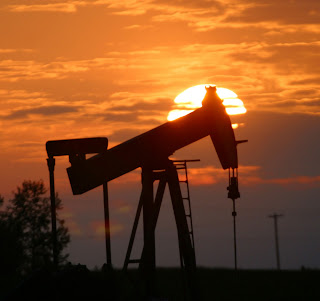The following is the first of a multi-part series:
The "Green" Revolution
On this site we have shown you some of the latest innovations in environmentally friendly technology. It is about time that we discuss how some of these technologies work, why they are important and how they impact our daily lives.
Before the industrial revolution of the 18th and 19th centuries much of agricultural, mining, manufacturing and transportation needs were fulfilled by human and animal labour. The largest limit on production was the number of "man-hours" available at any given time. Along with the industrial revolution came machines which reduced the need for manual labour. Since that time we have benefitted from the efficiencies which only machines can bring us.
It began with large steam powered engines in small numbers but we soon discovered internal combustion (oil based) engines, and innovation and growth production sky rocketed.
 |
| Oil Refinery Extraction Pump |
What we didn't envision, or perhaps ignored for too long, were the problems that came with depending oil for production. The most well publicised problem we face is the carbon emissions that are a by-product of burning fossil fuels. In order to use oil for energy, we must burn it to produce heat; the process of burning the fuel creates carbon dioxide, among others, which is a greenhouse gas. According to the majority of climate scientists, over the past century we have produced enough greenhouse gasses to significantly alter the atmosphere of the earth. Not surprisingly, increasing global populations and the industrialization of poor nations means we're headed towards even more greenhouses gas emissions.
The second problem we face, which is still not well known, is the depletion of oil reserves throughout the world. The oil that we use for energy can be burned very quickly but it is very difficult to make. The natural process which made the oil we use took a much longer time. Biomass, plants and animals, deep within the Earth must be compressed and/or heated under pressure for millions of years before it turns into oil. Since we cannot easily replenish the oil we call it a non-renewable energy source. A non-renewable energy source is any source which is not naturally replenished.
But the oil that we extract from the earth is not just used for energy; we also use it to make thousands of products. Over the last century we have turned petroleum into the plastics which make up toys, electronics, packaging materials, furniture, clothing, cosmetics, fertilizer, Styrofoam and thousands of other items. Most of these plastics are not recyclable, despite our best attempts at changing the manufacturing process. The items which cannot be recycled, such as Styrofoam, are contributing to the ever expanding landfills where they will break down to small pieces over thousands of years.
These are just three of the problems we are facing today, and clearly they are each large enough to warrant our attention. Together they are driving us towards a harsh future if do not act quickly to solve them.
In the next part of The "Green Revolution we'll take a look at the renewable sources of energy and how they work.
Read more on this article...

